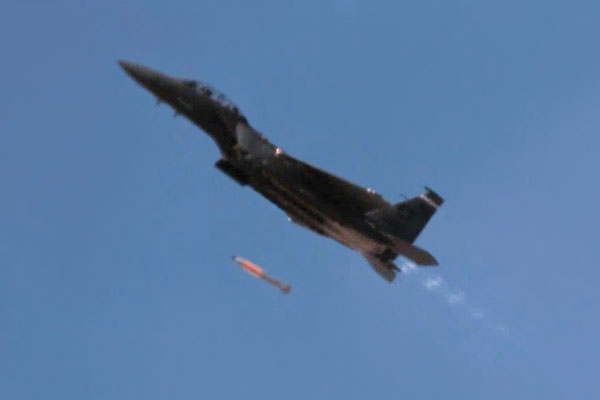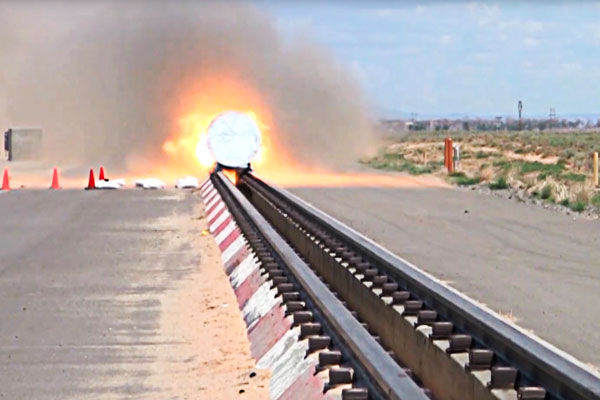Successful flight tests show Sandia’s design works with U.S. Air Force’s primary fighter jet

Dropped from above 25,000 feet, the mock B61-12 nuclear gravity bomb was in the air for approximately 55 seconds before hitting and embedding in the lakebed, splashing a 40- to 50-foot puff of desert dust from the designated impact area at Sandia’s Tonopah Test Range in Nevada.
That strike was the last in a series of flight tests designed to demonstrate the refurbished B61-12’s compatibility with the U.S. Air Force’s F-15E Strike Eagle jet fighter. The successful full-weapon system demonstration of the bomb’s compatibility with the jet increases confidence that it will always work when called upon by the president and never under any other circumstances.
“Sandia National Laboratories and the Air Force conducted the full-weapon system demonstration under a full end-to-end test scenario, demonstrating operational crews, representative carriage, release conditions and weapon functionality,” said Steven Samuels, a manager with Sandia’s B61-12 system team.
“We were able to test the B61-12 through all operational phases, and we have extremely high confidence the B61-12 is compatible with the F-15E Strike Eagle,” he said. “The results speak for themselves — the tests met all requirements, both in performance and safety. It was delivered with precision accuracy; it worked, and it worked well.”
Sandia is the design and engineering lab for non-nuclear components of the nation’s nuclear stockpile, including the B61-12. In addition to non-nuclear component development, Sandia serves as the technical integrator for the complete weapon, ensuring that the system meets requirements as a full-weapon system.
Tests show real-world capability

The early March demonstration of the fully functional weapon — containing non-nuclear and mock nuclear components — began with loading the weapon onto the fighter jet at Nellis Air Force Base near Las Vegas and ended with two flight tests at Tonopah Test Range. Initial data from the demonstration is consistent with the F-15E being fully certified to carry the refurbished bomb. The demonstration was possible with coordination among Sandia, Los Alamos National Laboratory, the Kansas City National Security Campus, NNSA and the Air Force.
“This is a full demonstration of a B61-12 delivery on an F-15E — verifying compatibility in real pre-flight and flight environments,” Steven said. “This is the real deal, minus the nuclear package. This test brought together years of planning, design, analysis, test and qualification to fully demonstrate the B61-12 on the F-15E Strike Eagle.”
On March 9, Air Force airmen used a mobile lift to raise and attach the inert B61-12 to the F-15E jet fighter. Mechanical connections and umbilical interface cables were verified to ensure the mock weapon was secure and digital and analog interfaces were properly configured and communicating between the aircraft and weapon.
The lower-altitude flight test took place at Tonopah Test Range, about 160 miles northwest of Las Vegas, on March 12. Flying at about 1,000 feet and at nearly the speed of sound, an F-15E released the mock weapon. The inert B61-12 struck the desert floor in the designated area about 35 seconds later.
A higher-altitude test occurred next, when an F-15E, again flying near Mach 1, released an inert B61-12 from above 25,000 feet. About 55 seconds later, the mock weapon embedded in the desert soil, again within the designated area.
“It was a successful test from our standpoint at the range. The forensic analysis of the test data is pending,” said Brian Adkins, manager at Tonopah Test Range. “We successfully executed the test within the parameters specified, and both jets returned home.”
Sandia design, engineering integral to B61-12 program
The full-weapon system demonstration coordinated with Sandia’s partners included final flight tests — the fifth and sixth overall — showing the compatibility of the B61-12 and F-15E, the first aircraft to complete the series of compatibility flights.

The compatibility testing is an essential part of the B61-12 Life Extension Program to refurbish, reuse or replace all components; extend the bomb’s service life by at least 20 years; and improve its safety, security and effectiveness. As part of the DOE/NNSA network of laboratories, Sandia is responsible for the design and engineering of non-nuclear components and production of custom electronics and is the technical integrator for the complete weapon. Los Alamos is responsible for production of detonators and other components.
A life extension program allows scientists and engineers to address the aging of nuclear weapons components. Some components are reused by being requalified to go back into a weapon without change. Others that have aged are remanufactured using the original specifications. Sometimes the original technology is no longer available, and Sandia redesigns those parts using modern technology.
The bomb, estimated at 12 feet long and weighing about 825 pounds, is being designed to be air delivered in either ballistic or guided-gravity drop modes. Along with the F-15E, the B61-12 will be certified for the Air Force’s B-2 strategic bomber, the dual capable F-16C/D fighter and, in the future, the fifth-generation F-35 fighter, as well as allies’ aircraft.
The first B61 entered service 50 years ago, and over the decades, numerous modifications have been made to increase safety and reliability. The B61-12 consolidates and replaces most of the previous variants. The NNSA recently announced plans to manufacture the first refurbished B61-12 in fiscal year 2022.
A full-weapon system demonstration ensures the refurbished bomb will work with the various aircraft used for national security, Steven said.
“It’s representative of the environment for the weapon,” he said. “The flight test is really everything coming together to say we’re good.”
Long-term effort
In early March at Sandia’s Tonopah Test Range, two flight tests were part of a full-weapon system demonstration to verify the refurbished B61-12’s compatibility with the U.S. Air Force’s F-15E Strike Eagle. The final compatibility test was a culmination of years of work that included ground testing and computer simulations as well as flight tests, said Steven Samuels, a manager with Sandia’s B61-12 system team.